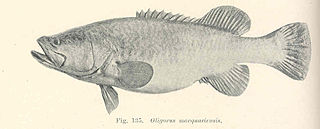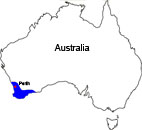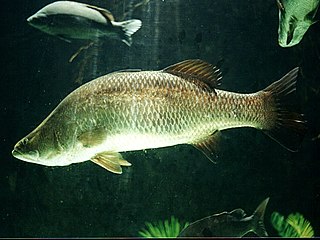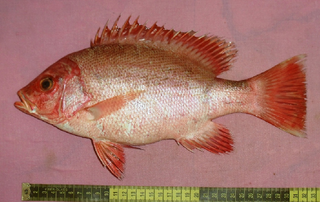
Perch is a common name for freshwater fish from the genus Perca, which belongs to the family Percidae of the large order Perciformes. The name comes from Greek: πέρκη, romanized: perke, meaning the type species of this genus, the European perch.

The trout cod or bluenose cod, is a large predatory freshwater fish of the genus Maccullochella and the family Percichthyidae, closely related to the Murray cod. It was originally widespread in the south-east corner of the Murray-Darling river system in Australia, but is now an endangered species.

The members of the family Percichthyidae are known as the temperate perches. They belong to the order Perciformes, the perch-like fishes.

Bourke's parrot, also known as the blue-vented parrot, sundown parrot, pink-bellied parrot, Bourke's parakeet, Bourke or "Bourkie", is a small parrot found in Australia and the only species in its genus, Neopsephotus. It is approximately 19 cm long and weighs around 45 grams. It is named after General Sir Richard Bourke, Governor of New South Wales from 1831 to 1837.

The Macquarie perch is an Australian native freshwater fish of the Murray-Darling river system. It is a member of the family Percichthyidae and is closely related to the golden perch.

The golden perch is a medium-sized, yellow or gold-coloured species of Australian freshwater fish found primarily in the Murray-Darling River system, though a subspecies is found in the Lake Eyre-Cooper Creek system, and another subspecies, suspected to be ancestral to all other populations, is found in the Fitzroy River system in Queensland. Other common names for golden perch are "goldens", “yellowbelly” and "callop", the last generally used only in South Australia.

The river blackfish is a freshwater fish endemic to the temperate waters of south-eastern Australia. It is found from southern Queensland through to central Victoria, including in the Murray-Darling river system. It is also found in some eastern and southern flowing coastal rivers. Found primarily in upland and "midland" habitats, though early records of fish fauna suggest it was originally far more extensively distributed and was found in some lowland habitats as well. Originally, river blackfish co-inhabited many of its lowland and "midland" habitats with species such as Murray cod and golden perch, and its upland habitats with species such as trout cod and Macquarie perch. It is a popular angling fish in some parts of its range.

The western pygmy perch is a species of temperate perch endemic to southwestern Australia.

The climbing perch is a species of amphibious freshwater fish in the family Anabantidae. A labyrinth fish native to Far Eastern Asia, the fish inhabits freshwater systems from Pakistan, India, Bangladesh and Sri Lanka in the west, to Southern China in the east, and to Southeast Asia west of the Wallace Line in the south. It is likely that Anabas testudineus is a species complex, with the binomial name applied to what are actually several different species. With further study, populations of this fish may be divided up into separate species and given new names. In Nepalese Terai it is called "Pothiya". In Bengali it is called "কৈ" (Koi). In Indonesia, it is known by many names, such as betok (Indonesian), běthik (Javanese), and papuyu (Banjarese)

Balston's pygmy perch, also known as Balston's perchlet, or king river perchlet, is a species of temperate perch endemic to Southwest Australia, where it occurs in coastal streams, ponds, lakes, and swamps. It prefers shallow, acidic waters with patches of sedge growth. This species can reach 9 cm (3.5 in) SL, though most do not exceed 6 cm (2.4 in). It can also be found in the aquarium trade.
The Yarra pygmy perch is a species of temperate perch that is endemic to southeastern Australia.
Nannoperca or pygmy perch is a genus of temperate perches endemic to freshwater systems of Australia.
The golden pygmy perch is a species of temperate perch endemic to Australia, where it is found in both Ewens Ponds and Deep Creek, South Australia, and several tributaries of the Glenelg River in Victoria. It prefers flowing water of ponds or small streams, generally being more commonly found in the streams that connect to the ponds, with plentiful vegetation or debris to provide shelter. It preys on extremely small crustaceans and aquatic insects. This species can reach 6.5 cm (2.6 in) SL. It can also be found in the aquarium trade.

The Donnelly River is a river in the South West of Western Australia. Its main tributaries are Barlee Brook and Carey Brook. The river runs primarily through state forest reserves, although 25 private landholdings are situated along the length of the river. Clearing of the catchment area is estimated at 20% with the land mostly being used for viticulture, horticulture, dairy, grazing and tourism.

Scortum barcoo is a species of ray-finned fish in the family Terapontidae, known by the common names Barcoo grunter and jade perch. It is endemic to Australia, where it can be found in certain major rivers, including the Barcoo River. It is reared in hatcheries.

Parapercis cylindrica, the cylindrical sandperch, is a species of sandperch belonging to the family Pinguipedidae.

Lutjanus erythropterus, the crimson snapper, crimson seaperch, high-brow sea-perch, Longman's sea perch, red bream, saddle-tailed perch, small-mouth nannygai or smallmouth sea perch is a species of marine ray-finned fish, a snapper belonging to the family Lutjanidae. It is found in the Pacific and Indian Oceans.

Lutjanus carponotatus, the Spanish flag snapper, stripey snapper, dusky-striped sea-perch, gold-banded sea perch, gold-stripe sea-perch, striped seaperch or stripey seaperch, is a species marine ray-finned fish, a snapper belonging to the family Lutjanidae. It is native to the western Pacific and Indian Oceans, from India to northern Australia.

The southern pygmy perch, also known as the Tasmanian pygmy perch, is a species of freshwater ray-finned fish, a temperate perch from the family Percichthyidae which is native to south-eastern Australia and Tasmania.

The little pygmy perch is a freshwater species of ray finned fish, a temperate perch from the family Percichthyidae that is endemic to south-western Western Australia. It is known from just four sites in the Denmark catchment. It is found in tannin stained, acidic and shallow streams in woodland dominated by Melaleuca rhaphiophylla.


















